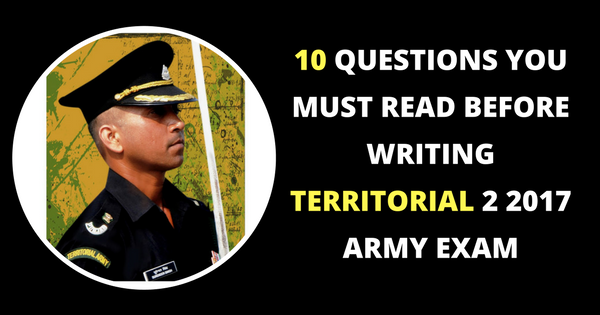Territorial Army 2 2017 Exam is going to conducted on the last day of the month of July 2017. Appearing candidates mus read the below given questions so that they can know this exam and its question pattern in a better way.
Territorial Army 2 2017 Exam Mock Test Series
10 Questions You Must Read Before Writing Territorial 2 2017 Army Exam

1) Look at this series: 36, 34, 30, 28, 24, … What number should come next?
A. 20
B. 22
C. 23
D. 26
2) In these series, you will be looking at both the letter pattern and the number pattern. Fill the blank in the middle of the series or end of the series.
SCD, TEF, UGH, ____, WKL
A. CMN
B. UJI
C. VIJ
D. IJT
3) Look carefully at the sequence of symbols to find the pattern. Select correct pattern.

A. 1
B. 2
C. 3
D. 4
4) Analogy- Poles : Magnet :: ? : Battery
A. Energy
B. Power
C. Terminals
D. Cells
5) Directions: Choose the figure which is different

A. 1
B. 2
C. 3
D. 4
6) If x = 4, y = 12 and x α y, then
A. 4y = 3x
B. x = 3y
C. y = 3x
D. 4x = 3y
7) A prime number N, in the range 10 to 50, remains unchanged when its digits are reversed. The square of such a number is
A. 1936
B. 1089
C. 484
D. 121
8) The first Muslim ruler who introduced a standing army was:-
(a) Al-ud-din-khilji
(b) Iltutmish
(c) Balban
(d) Firozshah Tughlaq
9) The upheaval of 1857 was first described as the war of independence by:-
(a) Jawaharlal Nehru
(b) Bal Gangadhar Tilak
(c) V D Savarkar
(d) Lala Lajpat Rai
10) ENGLISH COMPREHENSION
Read the following passage carefully to answer the questions given below (10 Marks)
Every breath came wheezing out of me like an asthmatic in trouble. My legs felt like lead and though it was cold and windy, my clothes were though it was cold and windy, my clothes were damp with sweat. “Only 30 minutes more,” said Qasimwani my much older and fitter forest guide and friend. What he never added was that the kilometre long trudge to our next nest-stop Sangargulu in upper Dachigam 4,000 metres above sea-level was almost straight up as he himself does’nt find the climb difficult. We had walked for five straight hours, starting from the lower reaches of Kashmir’s Dachigam National Park roughly following the route of the Himalayan glacier-fed Dagwan river up to its source. I had come to know and love this crystal mountain stream well. It sustained an incredible diversity in abundance of flora and fauna a nature coupled with animals before pouring its musical aqua into Srinagar’s famed Dal Lake; without the Dagwan, the health and economy of Srinagar would beat a risk. I thought to myself as I paused, frequently to take in the sight of sanctuary of black bears, yellow throated mantels, Dachigam’s endangered Hangul deer, Hanuman Langurd monkeys and the throb of buzz of bees and shrills of birds and multi-hued insects all around. And my word. The birds! Red billed blue magpies, redstarts , orioles and woodpeckers combined with warblers to set up an orchestra providing a welcome mist-laden breather from the leg-after-leg goat trek hike that stole my breath away. Like leaves of a book, every 1000 metres or so new stories unfolded as the national canvas changed. Verdant which are green and flourishing Chinar, Oak and Walnut gave way to higher elevation forests of silver Birch and Conifers where spiders and sawscaled vipers shared silent space in the dark root hollows of ancient trees. Above the treeline amidst Junipers and one of our planet’s most spectacular wild flower fields in Sungargulu, I momentarily caught my breath, lay down and slept for a while.
The 141 square kilometres Dachigam was a second home away from our Bombay home till the mid 1980’s. Back then Dachigam had its problems but they were different excess grazing, wood cutting, a sheep farm and trout hatchery in the heart of the park that we wanted out. Today there is a deep hollow, a pain. It is the relentless destruction of all that makes Kashmir. Kashmir beneath the picture postcard insets are deforested slopes, polluted rivers and lakes, and hard evidence of relentless march of climate change-much of it is the result of human interference resulting in melting glaciers, the retreat of junipers, early and late flowering, nesting and erratic migration. Such fluctuations are destabilizing the ecological foundations of Kashmir.
Is all lost then? Are the hundreds of other Himalayan valleys condemned to a fate worse than death? No, far from it, India as cautious hope can escape the worst impact of climate change if we act purposefully but the public will probably have to force the policy makers to move away from carbon energy and restore the many degraded ecosystems that sequester and store carbon, and buffer us from floods and droughts.
Q Choose the word from the passage which means green and flourishing.
(a) Sangargulu
(b) Verdant
(c) Conifers
(d) Treeline
Q According to the passage what stories unfolded as the author climbed up the Dachigam Sanctuary ?
(a) Of abundance of flora and fauna in nature
(b) Of rare birds
(c) Of Hangul Deer
(d) Of deforestation



















